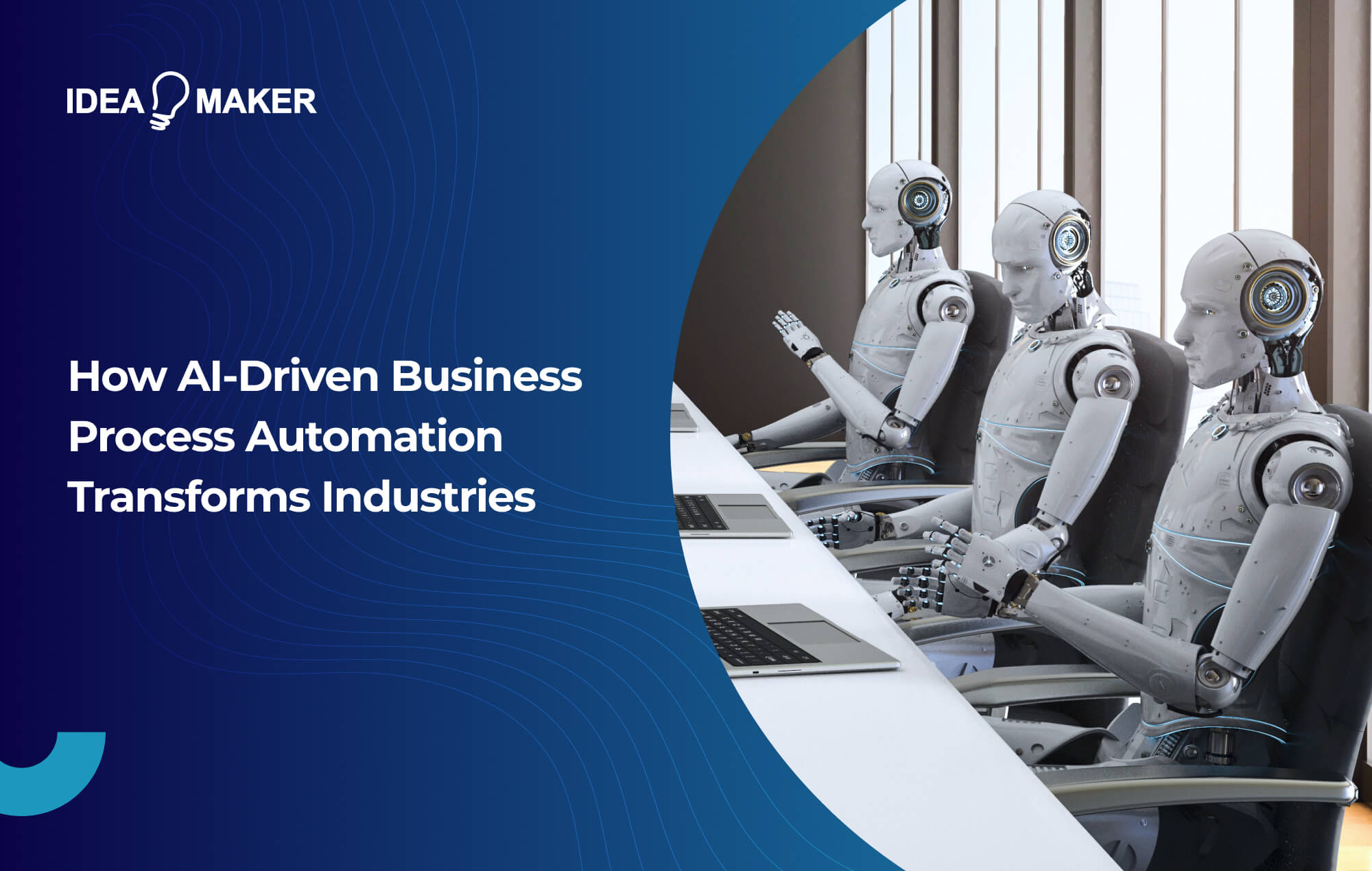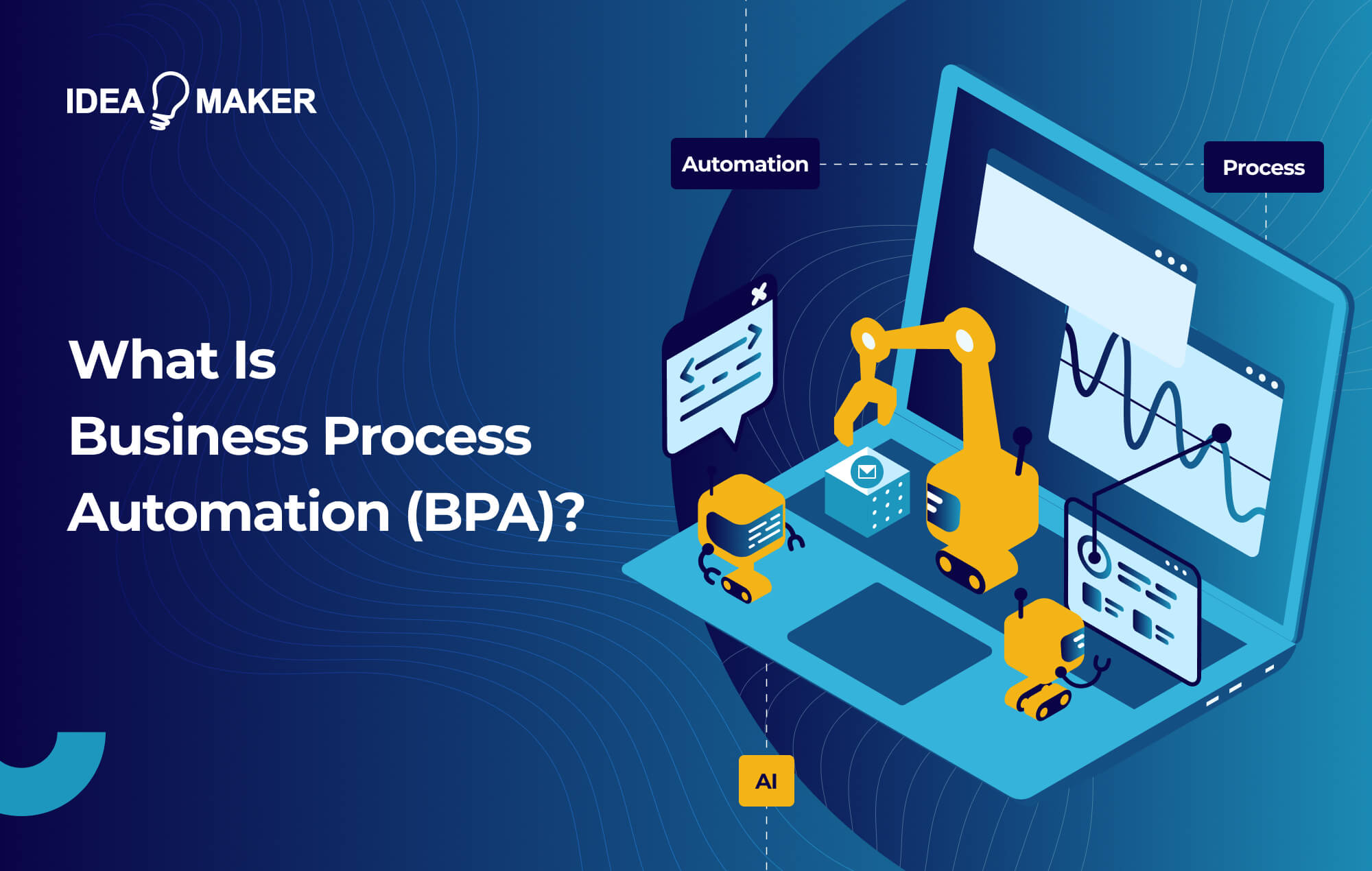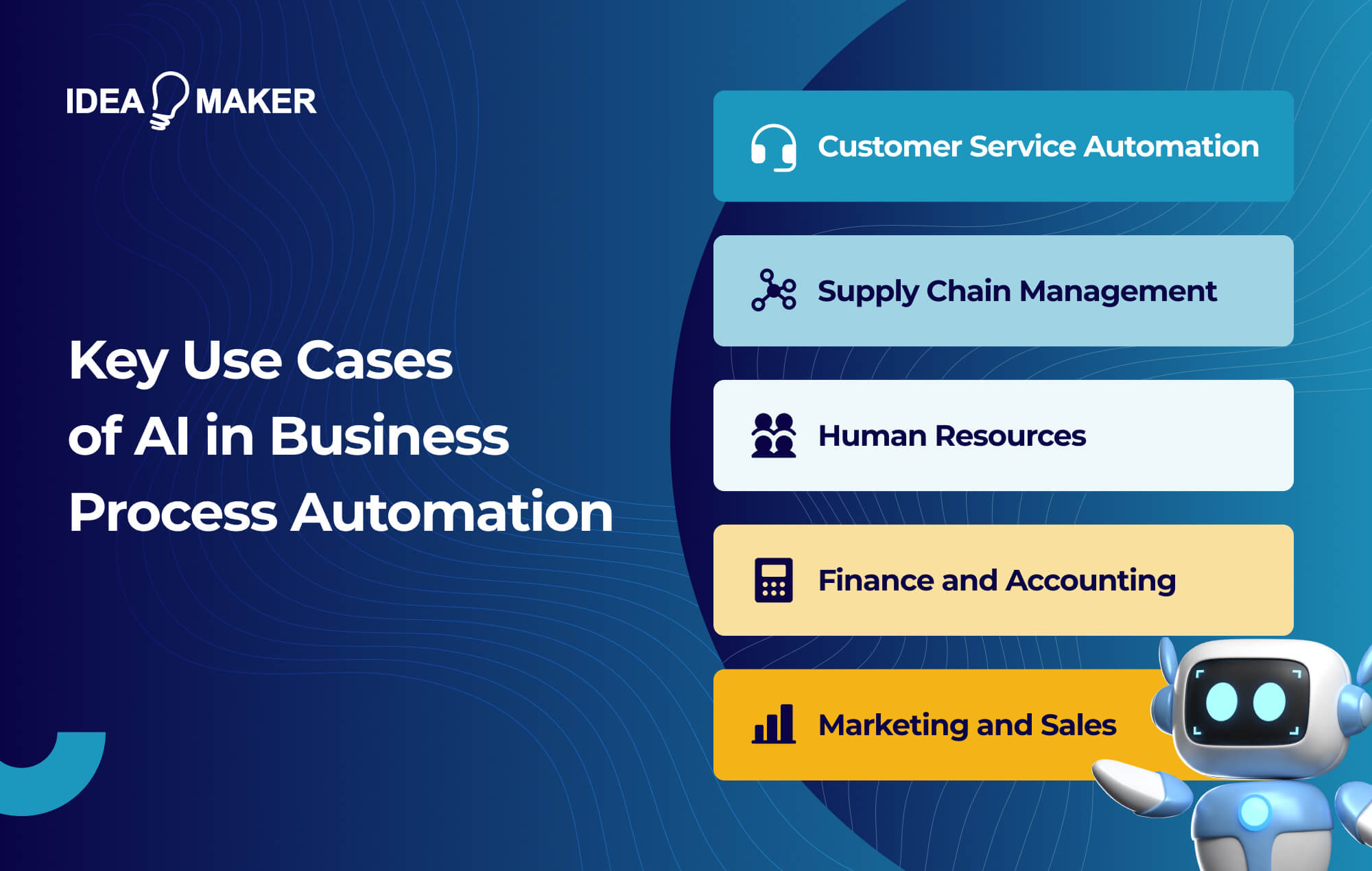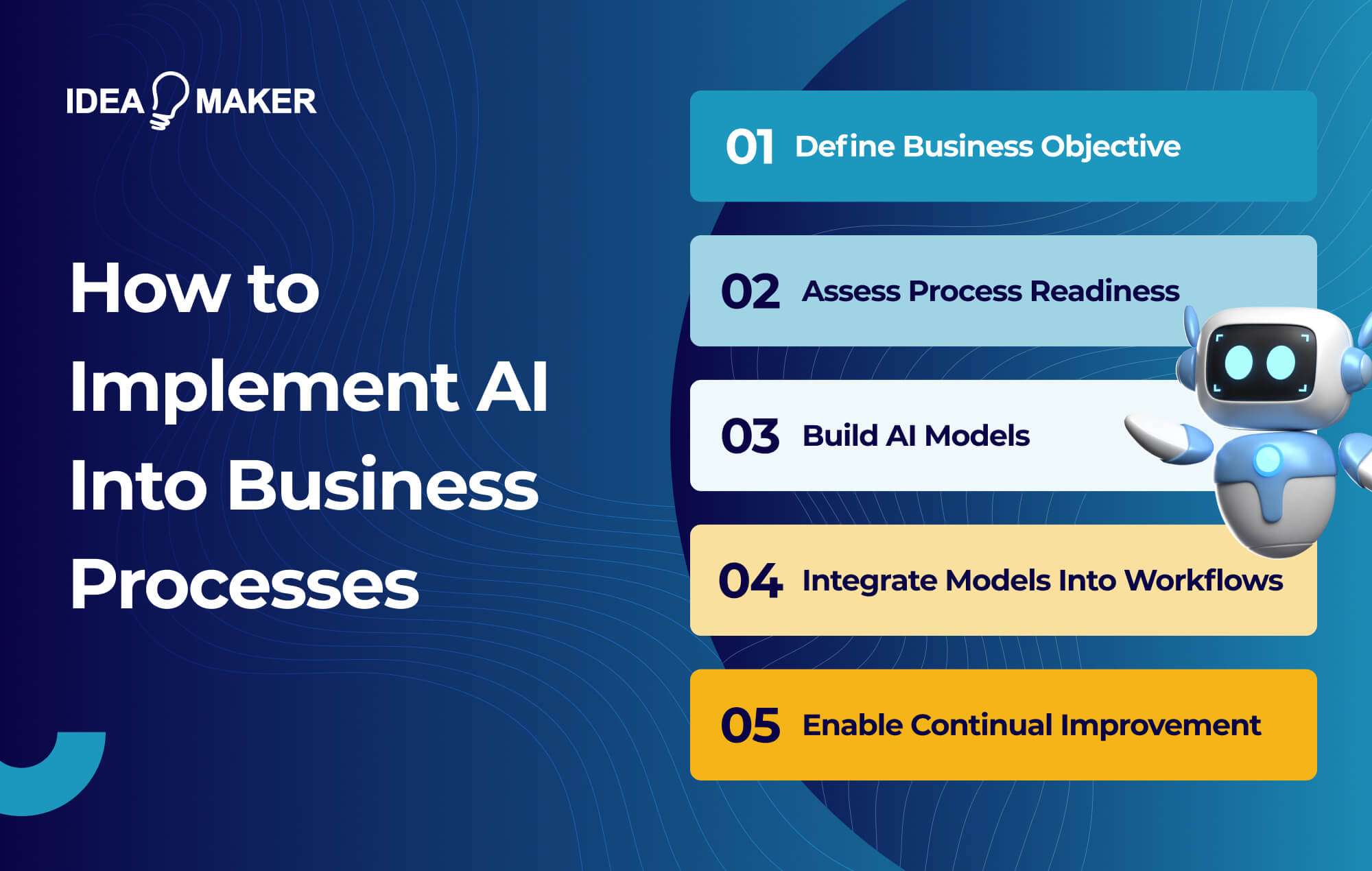Table of Contents
Business process automation (BPA) has transformed organization’s operations by streamlining repetitive, manual tasks. However, traditional BPA still relies heavily on rigid rules and human oversight.
The integration of artificial intelligence (AI) takes business process automation to the next level. AI introduces dynamic learning and predictive capabilities previously considered impossible.
AI can automate several business process types. As a result, AI-driven business process automation is revolutionizing various functions, from customer service to supply chain management. By incorporating technologies like machine learning and natural language processing, processes become more adaptive and accurate over time.
This article explores the real-world impact of AI in business process automation across different industries and how you can incorporate AI-driven business process automation in your business.
What Is Process Automation?
Process automation refers to the use of technology to automate processes that are repetitive, high-volume, and require cross-departmental workflows. It aims to improve efficiency and productivity by reducing human intervention in tasks that can be handled via automation. McKinsey’s projections indicate that by 2055, 50% of current work activities could potentially be automated.
At its core, process automation is about leveraging software applications and programs to mimic tasks traditionally carried out by human workers. This includes processes that rely on manipulating data, triggering responses, communicating across systems, and following rule-based decision trees.
Common examples include:
- Data entry or data transfer across business systems
- Automated email and calendar reminders
- Order fulfillment and inventory tracking
The workflow steps are defined once initially and then handled automatically by process automation tools instead of employees doing the same manual processes daily. This frees up human time and effort from repetitive tasks and minimizes errors from manual work.
While early process automation focused on simple, linear workflows, today’s tools can incorporate complex business logic, data transformations, integrations, and end-to-end intelligent automation across departments. This evolution is driven by artificial intelligence and machine learning capabilities.
What Is Business Process Automation (BPA)?
Business process automation refers to the automation of complex business processes and workflows that typically span multiple departments. It encompasses process automation capabilities but goes beyond simple, repetitive tasks to transform entire operations.
BPA tools and software suites provide a no-code way to integrate systems, standardize processes, track KPIs, and build rule-based logic across end-to-end workflows. This includes processes like:
- New customer onboarding
- Order-to-cash cycle
- Procure-to-pay processing
- Lead to opportunity to revenue tracking
These workflows require cross-functional coordination between sales, marketing, finance, HR, and IT teams. BPA connects discrete process automation tasks into an overall automated workflow orchestrated based on specified business rules.
The core capabilities offered by BPA platforms include:
- Drag-and-drop workflow builders for process mapping
- Prebuilt connectors to integrate enterprise applications
- Process analytics and intelligence through process mining
- Robotic process automation (RPA) to emulate user actions
- Business rule engines to model complex logic and decisions
With these capabilities, BPA aims to improve process efficiency, visibility, and continuous optimization across workflows that drive core business operations. Over 4 in 10 business leaders recognize that implementing workflow automation provides time savings and enables their staff to dedicate their efforts to more productive activities.
How AI Integrates With Traditional BPA Systems
While business process automation aims to standardize workflows, traditional BPA tools still have limitations in flexibility and intelligence. Pre-defined rules and process maps struggle to capture the complexities of real world situations.
Integrating artificial intelligence capabilities takes BPA to the next level by enabling dynamic decisions and continuous optimization. According to a recent study conducted by Deloitte, more than half of the surveyed organizations intend to integrate AI and automation technologies into their operations.
There are two primary ways AI augments existing BPA platforms:
-
Machine Learning Models
Traditional BPA relies on explicitly programmed logic and rules. But, machine learning models can detect patterns in process data and make predictions or recommendations that optimize workflows over time. These models self-improve as they process more data.
Use cases include:
- Predictive analytics to anticipate process outcomes
- Intelligent task assignment based on context
- Automated process changes based on insights
- Chatbots that understand process queries
-
Process Mining
Process mining analyzes system logs to identify bottlenecks, deviations, and opportunities to improve documented processes. While humans can miss issues in complex workflows, process mining AI detects these objectively.
Use cases include:
- Discovering broken processes that need fixes or re-design
- Spotting inefficient steps that exceed expected time or cost
- Monitoring conformance to standardized processes
- Quantifying process improvement opportunities
The combination of machine learning and process mining gives BPA the flexibility to handle real-world variability while still optimizing workflows. This human-in-the-loop approach combines AI insights with human experience. The end result is intelligent process automation that adapts dynamically while giving humans ultimate control.
Key Use Cases of AI in Business Process Automation
While business processes like customer service, supply chain, HR, finance, and marketing may appear to have little in common, they share some mutual challenges. Manual and disjointed workflows struggle with efficiency, accuracy, and delivering personalized experiences. Integrating AI drives transformative improvements across these critical business operations.
Customer Service Automation
Handling customer inquiries and issues is a crucial process that impacts customer satisfaction and loyalty. However, manual customer service commonly suffers from long wait times, varying response quality, high costs, and resolving complex inquiries.
AI-driven automation helps scale customer service operations while making them faster, smarter, and more personalized:
Example: AI chatbots for handling customer queries.
Smart chatbots integrate natural language processing to understand diverse customer questions. They leverage machine learning to improve answers based on real conversational data over time. Chatbots provide 24/7 self-service, redirect tricky inquiries seamlessly to human agents, and assist agents with recommendations.
Virtual customer assistants can also automatically pull customer data, history, and context to resolve issues faster. Augmented intelligence keeps humans in the loop while automating repetitive tasks such as information retrieval.
Supply Chain Management
Managing global supply chains involves complex workflows with multiple interdependent steps. Disruptions can ripple across the end-to-end process. AI helps coordinate workflows more effectively while optimizing costs and efficiency.
Example: AI for inventory forecasting and logistics optimization.
AI algorithms can analyze past demand, pricing data, promotions, and even external signals like weather to improve inventory and production forecast accuracy. Optimization algorithms use these forecasts to tune logistics plans by recommending ideal routes, shipment sizes, and inventory policies per location.
Some supply chain organizations have been able to reduce inventory costs while maintaining or improving customer service levels after implementing AI-driven logistics and forecasting tools.
Human Resources
HR teams handle multifaceted processes like recruiting, onboarding, learning, and more. These workflows bring together people, systems, and policies. AI helps manage complexity while personalizing HR processes.
Example: AI for resume screening and employee onboarding processes
AI can screen thousands of resumes to automatically identify the most qualified candidates based on historical hiring data, job descriptions, and desired skills. Chatbots then engage candidates to schedule interviews.
Once hired, the onboarding process is carried out via AI. Key HR paperwork, access permissions, equipment, and training are automatically triggered and tracked by AI workflows. Chatbots answer common new hire questions, with seamless handoffs to human HR staff when needed.
Finance and Accounting
Finance teams handle high-volume, data-intensive processes from accounts payable and receivable to financial planning and analysis. AI helps automate these complex workflows for greater efficiency, insights, and accuracy.
Example: Automated invoice processing and fraud detection using AI.
Intelligent document processing tools extract key details from invoices, bank statements, contracts, and other financial documents without any manual data entry. Invoice handling costs can be reduced using these AI systems.
Predictive analytics algorithms also help detect anomalies and patterns indicative of financial process fraud or risk automatically without needing complex rules. This prevents revenue leakage and monetary losses.
Marketing and Sales
Marketing and sales teams aim to boost pipeline growth and conversions through campaigns and content. Manual processes struggle to capture complex customer signals and personalize engagement.
Example: AI-powered predictive analytics for customer behavior
Advanced analytics algorithms track millions of customer data points to detect micro-segments and predict future behaviors. These guide highly personalized, contextual campaign targeting and content recommendations.
Chatbots also qualify leads 24/7 by understanding natural customer questions and needs. Qualified leads get routed to sales instantly, while chatbots nurture other prospects.
As the examples illustrate, AI is making significant inroads across diverse business processes. Whether handling millions of customer conversations, orchestrating global logistics, or detecting complex financial fraud, AI handles scale and complexity beyond human capacity.
Benefits of AI-Driven Business Process Automation
The business case for AI-driven process automation goes far beyond basic task automation. Advanced capabilities such as machine learning, predictive analytics, and natural language processing create intelligence not possible in traditional workflows.
When combined, these leading-edge technologies drive transformational improvements across critical metrics like productivity, costs, accuracy, innovation, and risk management. Some of the most compelling benefits of integrating artificial intelligence into business process automation include:
Increased Productivity
A major benefit of integrating AI into business processes is enhanced productivity and efficiency. When manual, repetitive tasks are automated, human employees can focus on higher-value work that requires strategic thinking, creativity, and emotional intelligence.
Within business processes, AI handles high-volume, rules-based tasks such as data entry and transfers, calculations, application interactions, and customer response handling. Humans oversee exceptions, quality control, governance, and continuous improvement. This combination of AI productivity and human judgment drives optimal outcomes.
Extensive Data Analysis
Another major benefit of AI-driven business process automation is extensive data analysis for insights and optimization. While humans struggle to spot patterns in large volumes of data, AI algorithms can process millions of data points to detect correlations, make predictions, and guide decisions. This can lead to process improvements humans would never identify manually.
For example, an AI algorithm may process five years of support call logs discovering that a particular series of troubleshooting steps resolve issues faster than standard protocols. Or, it may reveal that order approval rates are 15% higher for customers who engaged with an onboarding sequence.
These insights can then be leveraged to optimize processes like call workflows, order approvals, payment terms, and more to improve outcomes. Over time, continuous analysis and learning lead to compounding process improvements that are not possible otherwise.
Effective Risk Management
Business processes inevitably involve risks–whether it’s revenue leakage in finance, quality issues in manufacturing, or delays that impact customer service. Humans using traditional analytical approaches only identify a fraction of potential process risks.
However, AI algorithms can rapidly analyze millions of transactions to detect anomalies and emerging risk patterns in real-time. This allows organizations to proactively address risks before they escalate through predictive analytics and monitoring.
For example, AI can analyze payment data to flag suspicious invoices or transactions as potential fraud. It can detect supply chain delays through inventory monitoring algorithms days in advance. Chatbots also mitigate customer service risks through automated responses that deescalate issues.
Together, these prevent minor process anomalies from cascading into major problems. Effective risk management using AI’s predictive capabilities ensures optimal outcomes and business continuity.
Real-Time Decisions
Humans depend heavily on periodic reporting and lagging indicators to make process-related decisions. However, AI enables real-time decision-making by continuously analyzing data streams.
For example, an AI model can combine live signals like order volumes, weather forecasts, traffic data, and production line speeds. It can then recommend dynamic changes to supply chain plans and inventory levels in real-time to optimize costs and customer service.
Similarly, a customer service chatbot analyzes visitor clicks, questions asked, and browsing history to offer relevant products or self-help suggestions instantly within the same conversation.
This real-time optimization at the point of action allows organizations to be far more responsive to customers and to change market dynamics through AI-driven processes. Decision lag times are reduced from weeks or days to minutes or seconds.
Fostering Innovation
Beyond immediate process improvements, AI-driven automation also fosters lasting business innovation. As repetitive tasks are automated, human employees have more bandwidth for creative, strategic projects rather than fighting daily fires.
Employees can tap into their innate human potential for imagination, curiosity, and visionary thinking with the time and mental space to experiment. This leads to new ideas and innovative initiatives that create step-function value.
For example, claims processing staff in an insurance company could use their free time to brainstorm a customer loyalty program. A finance team could build an interactive self-service portal to answer common customer invoice questions that arise after AI bots have handled routine inquiries.
Such innovation and transformations emerge organically by leveraging employees’ creative energy alongside AI. This culture of experimentation and progress ultimately drives competitive differentiation.
Decreasing Operational Expenses
Process automation on its own provides major cost savings by reducing human labor needed for routine tasks. However, AI magnifies these savings even further for business processes. As AI handles rising process volumes and complexity over time, cost savings compound year-over-year. This leads to a material impact on expense structures and profit margins.
While the upfront effort of integrating AI into workflows feels incremental, the long-term benefits are exponential and compounding in nature. Within a few years, processes augmented by artificial intelligence perform at levels unimaginable through legacy automation.
How to Implement AI Into Business Processes
Integrating artificial intelligence into workflows represents a major transformation initiative for most companies. Success requires a structured approach spanning people, processes, data, and technology. Key steps include:
-
Define Business Objectives
First, companies should identify the key processes for AI automation based on pain points, return on investment, and strategic priorities. Setting clear business goals and metrics provides direction, such as improving customer response times by 50% or reducing financial risk by 30%.
-
Assess Process Readiness
Next, assess processes for automation readiness across factors such as standardization, data formats, integration needs, and user readiness for transparency. Cleaning historical logs and data issues is essential prep work as well. Evaluating complexity upfront accurately charts the scope.
-
Build AI Models
With processes selected and prepared, AI models can be built leveraging historical data. Techniques like supervised learning, reinforcement learning at scale, deep learning, and natural language processing are commonly used. Multiple modeling approaches may be needed for different processes.
-
Integrate Models Into Workflows
The built AI models are then integrated into process steps through application programming interfaces and decision engines. User interfaces adapt to allow transparency into model logic, explanations, and human overrides. Change management ensures adoption across affected teams.
-
Enable Continual Improvement
Finally, continual learning cycles allow the AI to improve continuously based on new data. Maintaining human oversight, monitoring model performance, refreshing models, and enabling user feedback leads to sustainable success.
With this phased, iterative approach, companies can transform operations by embedding intelligence into their most important workflows over time. This human -AI collaboration is the future of process automation.
How Idea Maker Can Help You in AI Business Process Automation
While the benefits of AI process automation seem appealing, most companies need support with the complexities of implementation. From identifying the right use cases to change management, AI integration is still new for many organizations.
This is where working with seasoned experts pays dividends. IdeaMaker specializes in delivering AI-driven digital transformation for clients across industries. Our automated solutions combine the best of human insight and AI capabilities for sustainable success.
Through consulting and hands-on implementation, IdeaMaker shepherds clients through the end-to-end AI journey–from identifying opportunities to measuring return on investment. We make AI approachable and actionable for true digital transformation. Reach out to our team today to learn more.

















